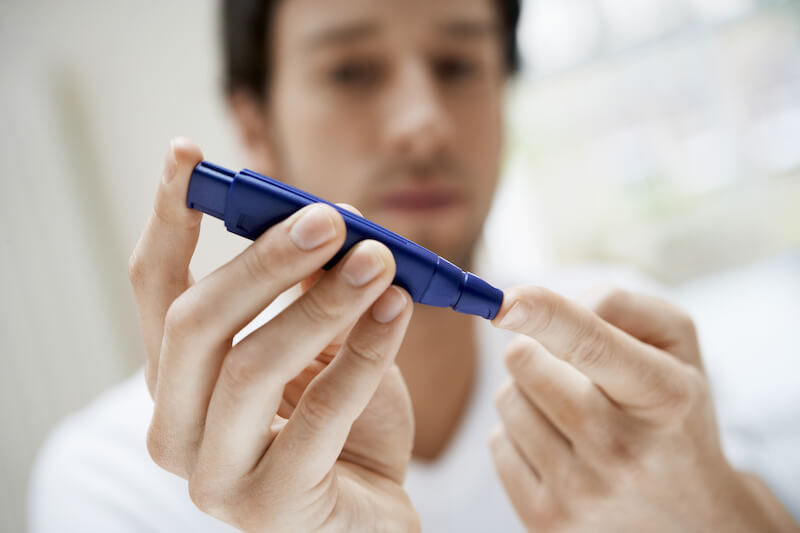| 04. July 2023
Why diabetes can lead to hair loss

- Hair loss can be a symptom of undetected metabolic diseases.
- Diabetes mellitus impairs hair cell metabolism.
- A whole range of causes lead to diffuse hair loss.
- If the doctor adjusts the blood sugar correctly, the hair loss should stop.
Hair loss and sudden thinning hair can be one of the first visible symptoms of diabetes mellitus. After a diabetes diagnosis, hair loss is certainly not the biggest problem for those affected. However, knowledge of the interplay between diabetes and hair loss, as well as treatment options, is a great motivation to get type 2 diabetes under control.
Diabetes Hair Loss: Causes
Diabetes negatively impacts all metabolic processes in the body, including cell metabolism at the hair roots. It's likely not just one disruptive factor that leads to hair loss, but rather a whole host of causes. If cell division and cell growth at the hair roots aren't optimal, the hair follicles end the hair growth phase prematurely. Below, we list the causes of diffuse hair loss in diabetes mellitus.
Circulatory disorders
Elevated blood sugar levels damage small blood vessels over the years (diabetic microangiopathy). The supply of energy and oxygen, as well as proteins for hair keratinization, to the scalp and hair follicles comes to a halt.
Energy deficiency
If the transport of glucose into the cell interior, where the glucose is subsequently used to generate energy (glycolysis), cannot take place due to a lack of insulin, the hair follicles must stop growing hair.
Autoimmune disorders
High blood sugar disrupts the immune system. The body becomes more susceptible to infections. If defense cells attack hair follicles when they lose their immune privilege, alopecia areata occurs. Hair falls out practically overnight.
Dry scalp
When fluid loss occurs due to increased urine excretion (glucosuria), the skin and scalp tend to become dry. A persistently dry, irritated, and inflamed scalp makes it difficult for the hair follicles to maintain the hair growth phase.
stress
The lifestyle changes associated with type 2 diabetes—for example, regularly taking medication or injecting insulin—cause stress. The release of stress hormones and inflammatory reactions disrupt the cellular metabolism of hair follicles.
Medications
Certain pharmacological substances hinder cell metabolism at the hair roots, for example the formation of hair keratin, and interrupt hair growth.
What is diabetes mellitus?
Diabetes mellitus ( ancient Greek Diabetes mellitus (also known as "honey-sweet flow") is a collective term for numerous metabolic disorders of the body. The term diabetes mellitus describes a primary symptom, namely the excretion of sugar in the urine. How does diabetes mellitus develop?
The carbohydrates ingested with food, such as potatoes, rice, or grains, such as bread, are broken down into glucose (grape sugar) in our gastrointestinal tract and released into the blood via the intestines. The metabolic hormone Insulin , which is produced in the pancreas, causes glucose to be transported into the cell interior, where the glucose is used to produce energy in a process called glycolysis.
When glucose no longer reaches the body's cells due to an insulin deficiency or insulin resistance, the body experiences hyperglycemia, and blood sugar levels rise. This is why diabetes is also called diabetes mellitus. Hypoglycemia, on the other hand, can occur as a result of treatment with insulin medications.
Diabetes isn't always just a disruption of carbohydrate metabolism. Fat and protein metabolism are often disrupted. This also affects hair growth. However, thinning hair is not an indication of hair loss. Hair will regrow when the cellular metabolism of the hair follicles returns to balance.
Treating diabetes hair loss
People suffering from hair loss may learn from their dermatologist that hair loss is a symptom of diabetes. Now it's time to set priorities: get diabetes under control first, then address hair loss.
Adjust blood sugar
The most important measure after a diagnosis of diabetes mellitus is treating hyperglycemia, because it can lead to cardiovascular, eye, and kidney diseases, nerve disorders, and, not least, diabetic foot. Type 2 diabetics also have a higher risk of developing arteriosclerosis. Well-controlled blood sugar levels help mitigate, delay, or even prevent secondary diseases. Physicians have both non-drug and drug treatments at their disposal.
Non-drug treatment
Reducing body weight through a healthy diet and physical activity is an effective measure, especially for overweight patients. A healthy diet means a varied and balanced diet. Foods should be low in fat and high in carbohydrates and fiber. Internists recommend Approximately 50% carbohydrates, 30 to 35% fat, 15 to 20% protein. Sugar substitutes are not included in the sugar balance.
Drug treatment
Depending on whether treatment goals have been achieved, the extent of metabolic dysfunction, and the stage of type 2 diabetes, medications to lower blood sugar (antidiabetics) such as insulin preparations are used. The physician selects the appropriate medication, determines the dosage, and coordinates the appropriate diet with the patient.
READ BY 23,000 PEOPLE
Join 23,000 others and find out how to improve your hair health with great offers and discounts as well as helpful advice











